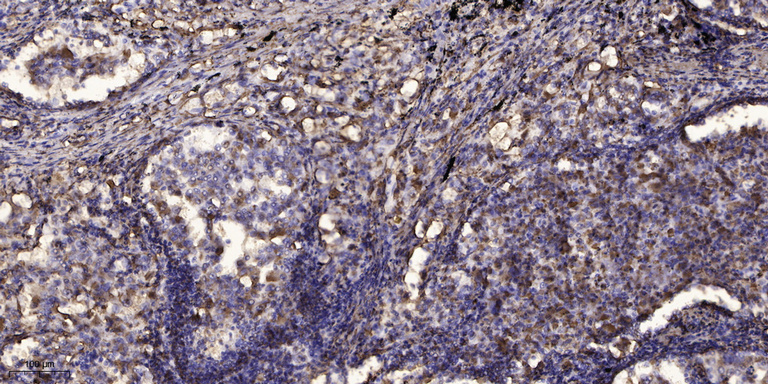Smad7 (Acetyl Lys70) rabbit pAb
- Catalog No.:YK0168
- Applications:WB;IHC
- Reactivity:Human;Mouse;Rat
- Target:
- Smad7
- Fields:
- >>TGF-beta signaling pathway;>>Hippo signaling pathway
- Gene Name:
- SMAD7 MADH7 MADH8
- Protein Name:
- Smad7 (Acetyl Lys70)
- Human Gene Id:
- 4092
- Human Swiss Prot No:
- O15105
- Mouse Gene Id:
- 17131
- Mouse Swiss Prot No:
- O35253
- Rat Gene Id:
- 81516
- Rat Swiss Prot No:
- O88406
- Immunogen:
- Synthesized peptide derived from human Smad7 (Acetyl Lys70)
- Specificity:
- This antibody detects endogenous levels of Human,Mouse,Rat Smad7 (Acetyl Lys70)
- Formulation:
- Liquid in PBS containing 50% glycerol, 0.5% BSA and 0.02% sodium azide.
- Source:
- Polyclonal, Rabbit,IgG
- Dilution:
- WB 1:500-2000;IHC 1:50-300
- Purification:
- The antibody was affinity-purified from rabbit serum by affinity-chromatography using specific immunogen.
- Concentration:
- 1 mg/ml
- Storage Stability:
- -15°C to -25°C/1 year(Do not lower than -25°C)
- Other Name:
- Mothers against decapentaplegic homolog 7 (MAD homolog 7;Mothers against DPP homolog 7;Mothers against decapentaplegic homolog 8;MAD homolog 8;Mothers against DPP homolog 8;SMAD family member 7;SMAD 7;Smad7;hSMAD7)
- Molecular Weight(Da):
- 47kD
- Background:
- The protein encoded by this gene is a nuclear protein that binds the E3 ubiquitin ligase SMURF2. Upon binding, this complex translocates to the cytoplasm, where it interacts with TGF-beta receptor type-1 (TGFBR1), leading to the degradation of both the encoded protein and TGFBR1. Expression of this gene is induced by TGFBR1. Variations in this gene are a cause of susceptibility to colorectal cancer type 3 (CRCS3). Several transcript variants encoding different isoforms have been found for this gene. [provided by RefSeq, Jun 2010],
- Function:
- disease:Genetic variations in SMAD7 influence susceptibility to colorectal cancer type 3 (CRCS3) [MIM:612229]. Colorectal cancer consists of tumors or cancer of either the colon or rectum or both. Cancers of the large intestine are the second most common form of cancer found in males and females. Symptoms include rectal bleeding, occult blood in stools, bowel obstruction and weight loss. Treatment is based largely on the extent of cancer penetration into the intestinal wall. Surgical cures are possible if the malignancy is confined to the intestine. Risk can be reduced when following a diet which is low in fat and high in fiber.,function:Antagonist of signaling by TGF-beta (transforming growth factor) type 1 receptor superfamily members; has been shown to inhibit TGF-beta (Transforming growth factor) and activin signaling by associating with their receptors thus preventing SMAD2 access.
- Subcellular Location:
- Nucleus . Cytoplasm . Interaction with NEDD4L or RNF111 induces translocation from the nucleus to the cytoplasm (PubMed:16601693). TGF-beta stimulates its translocation from the nucleus to the cytoplasm. PDPK1 inhibits its translocation from the nucleus to the cytoplasm in response to TGF-beta (PubMed:17327236). .
- Expression:
- Ubiquitous with higher expression in the lung and vascular endothelium.
- June 19-2018
- WESTERN IMMUNOBLOTTING PROTOCOL
- June 19-2018
- IMMUNOHISTOCHEMISTRY-PARAFFIN PROTOCOL
- June 19-2018
- IMMUNOFLUORESCENCE PROTOCOL
- September 08-2020
- FLOW-CYTOMEYRT-PROTOCOL
- May 20-2022
- Cell-Based ELISA│解您多样本WB检测之困扰
- July 13-2018
- CELL-BASED-ELISA-PROTOCOL-FOR-ACETYL-PROTEIN
- July 13-2018
- CELL-BASED-ELISA-PROTOCOL-FOR-PHOSPHO-PROTEIN
- July 13-2018
- Antibody-FAQs
- Products Images

- Immunohistochemical analysis of paraffin-embedded human Squamous cell carcinoma of lung. 1, Antibody was diluted at 1:200(4° overnight). 2, Tris-EDTA,pH9.0 was used for antigen retrieval. 3,Secondary antibody was diluted at 1:200(room temperature, 45min).


